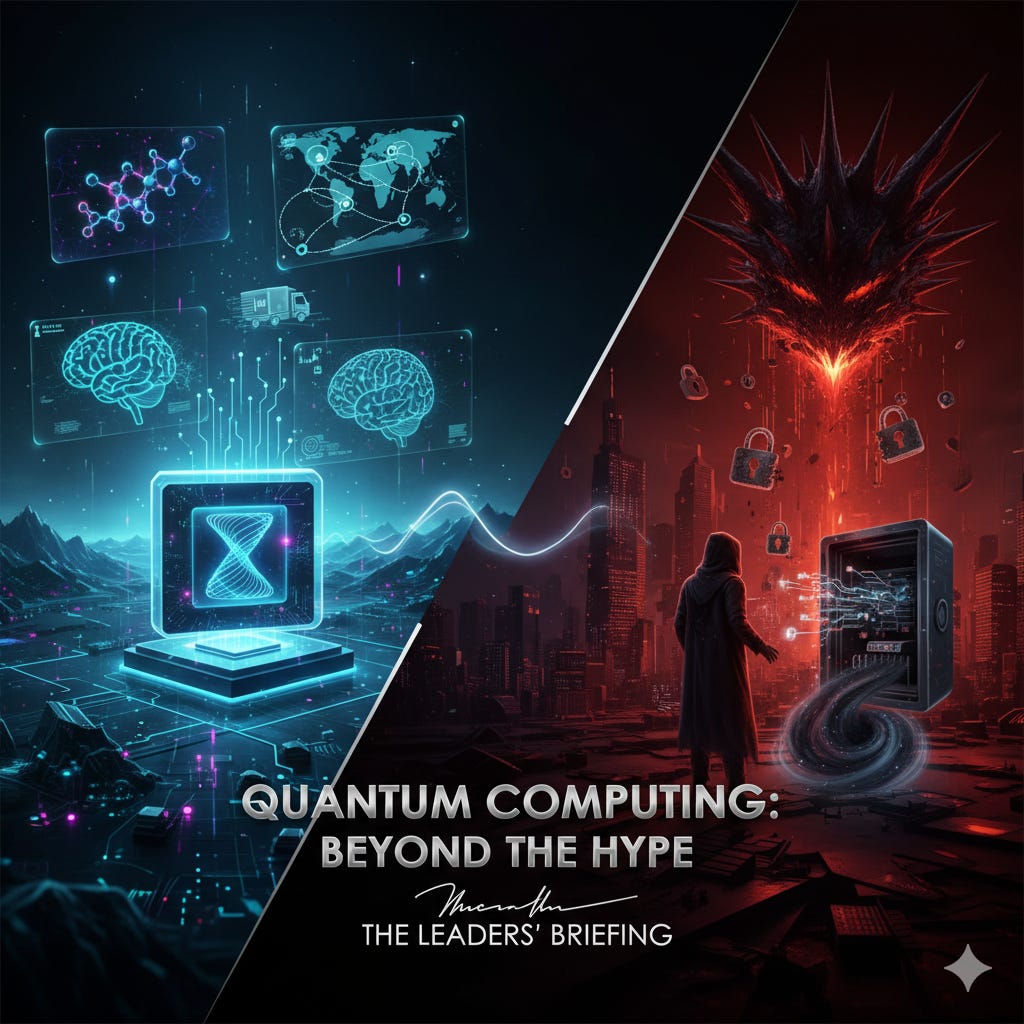Quantum Computing: Your Next Great Opportunity
How to Harness the Future of Innovation Before Your Competitors Do.
As leaders, we’re paid to look around the corner. We track trends, anticipate disruptions, and position our organizations for the future. Yet, one technology on the horizon feels more like science fiction than strategic reality: quantum computing.
Many people dismiss quantum computing as a distant academic curiosity, but that is a strategic mistake. Quantum computing is not merely an incremental advancement; it represents a fundamental shift in how we understand computation. Grasping its core principles is no longer optional—it is essential for navigating the next decade of innovation and security. This isn’t about becoming a quantum physicist; it’s about understanding the strategic implications of these advancements.
The Quantum Leap: From Predictable Bits to Probabilistic Qubits
For fifty years, we have built our digital world on a simple and reliable foundation: the bit. Like a light switch, a bit can be either ON (1) or OFF (0). It is binary and predictable. Every piece of software, every encrypted file, and every network packet is constructed from this basic certainty.
Now, quantum computing introduces a new element: the qubit. Unlike the traditional bit, a qubit operates based on the unusual and powerful principles of quantum mechanics. It possesses two unique capabilities that will redefine what is computationally possible.
Superpower 1: Superposition
Imagine a spinning coin. While it is in the air, it is neither heads nor tails; it is a blend of both possibilities. This concept is known as superposition. A qubit can exist as a combination of both 0 and 1 at the same time.
By linking qubits together, a quantum computer can explore an exponential number of outcomes simultaneously. For example, two qubits can represent four different states at once, and three qubits can represent eight states. Remarkably, a mere 300 qubits could represent more states than there are atoms in the entire known universe. This capability is not just about processing faster; it’s about exploring a vast problem space all at once.
Superpower 2: Entanglement
Einstein famously referred to it as “spooky action at a distance.” Entanglement describes a profound connection between two qubits. Once they are entangled, they behave as a single system, regardless of how far apart they are. If you measure one qubit and find its state is 0, you instantly know that its entangled partner’s state is 1.
This connection enables incredibly complex and correlated calculations, making quantum computers uniquely suited for solving problems involving intricate systems, such as designing new molecules or breaking complex codes.
The Strategic Impact: Opportunity and Urgency
While a quantum computer may not replace your laptop for everyday tasks like sending emails, it holds the potential to create new markets and disrupt existing ones significantly. For leaders, understanding these implications is crucial, as they can be categorized into two vital areas:
The Opportunity: Solving the “Unsolvable”
Quantum computing has the potential to solve problems that are currently too complex for even the most powerful supercomputers. Forward-thinking leaders should pay attention to breakthroughs in the following areas:
Pharmaceuticals and Materials Science: Quantum computing can aid in designing new drugs and innovative materials by accurately simulating molecular interactions. This advancement could reduce research and development cycles from years to just a few months.
Logistics and Optimization: It can resolve complex optimization challenges related to supply chains, financial modeling, and energy distribution, leading to unprecedented efficiency and significant cost savings.
Artificial Intelligence and Machine Learning: Quantum computing can enhance machine learning models by analyzing large datasets to identify optimal solutions in ways that classical computers cannot achieve.
The Threat: The “Quantum Apocalypse” for Cybersecurity
Here is the urgent call to all tech and cyber leaders:
The security of our entire digital infrastructure—from banking systems to national defense—hinges on robust encryption standards like RSA. These standards exploit the mathematical complexity of factoring large numbers, a task that remains daunting for classical computers.
However, the rise of large-scale quantum computers using Shor’s algorithm threatens to change the game entirely, rendering this challenge trivial. This is not merely a concern for the future; it is an immediate danger to the integrity of our data. Cyber adversaries are actively engaging in “harvest now, decrypt later“ strategies, gathering and storing encrypted information today in anticipation of when quantum computing becomes a reality. Critical data with long-term significance—such as government secrets, intellectual property, and financial records—is already vulnerable.
Now is the time to act! We must prioritize advancing our encryption methods and prepare for the inevitable challenges posed by quantum technology. The security of our digital future depends on it.
Your Action Plan: Becoming “Quantum-Ready”
The shift to a post-quantum world won’t happen overnight, but taking action now is essential for your organization’s future.
Conduct a Quantum Risk Assessment: It’s vital to understand where you currently rely on cryptography and to pinpoint your most sensitive, long-term data. Identify what needs safeguarding for the next 10 to 20 years—this is not just an option; it’s a necessity.
Explore Post-Quantum Cryptography (PQC): The National Institute of Standards and Technology (NIST) is actively standardizing new cryptographic algorithms that can withstand attacks from both classical and quantum computers. Don’t wait—start delving into these standards and develop a strategic roadmap for migration to ensure your defenses are ahead of the curve.
Emphasize Crypto-Agility: The ability to effortlessly switch cryptographic algorithms is crucial in this evolving landscape. Is your infrastructure capable of adapting to new standards without undergoing a complete overhaul? Make flexibility a priority to stay resilient.
The quantum era is on the horizon, bringing with it unprecedented opportunities and significant security threats. Leaders who recognize its implications and take proactive steps today will be the ones who not only survive but thrive in this new reality. Don’t get left behind—embrace the change and position your organization for success.



